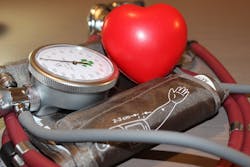Scientists peering into the beating heart have solved a decades-old, fundamental mystery about how the heart works. The revelation could herald the development of new treatments for heart diseases – the leading cause of death worldwide, according to a news release from Florida State University.
Researchers from Eastern Virginia Medical School, Florida State University and the University of Virginia have observed a tiny muscle filament during a crucial stage in a beating heart for the first time. The research was published in Proceedings of the National Academy of Sciences.
The heart is a unique muscle which contracts and relaxes about once every second in most people. Each heartbeat relies on cyclical interactions between thick and thin filaments in the heart muscle – a process orchestrated by rising and falling levels of calcium.
During the “systolic” phase, calcium binds to thin filaments and allows interactions with thick filaments to produce the force required for heart muscle to contract.
Researchers worked for two years to tackle the technical challenges presented by the complex structure of the thin filament and the difficulty in preparing the specimen for examination.
With those challenges overcome, the team used cryo-electron microscopy to directly observe the thin filament structure as the heart contracts and beats, findings that open up a new avenue for heart disease research.
“We can now fully understand how inherited diseases of the heart affect its capability to work,” said Jose R. Pinto, associate professor of biomedical sciences at Florida State University. “Basically, we created a new structural model for the cardiac thin filament, and based on that, we can now address several existing questions about the functioning of the heart in health and disease.”
The research team’s data reveal how parts of the thin filament cooperate to transition from the diastole phase of the heartbeat – when the heart muscle is relaxed – to systole, when the heart muscle contracts and pumps blood.
The research was groundbreaking for several reasons, said co-investigator P. Bryant Chase, a professor of biological science at Florida State University. That includes the identification of individual structures along thin filaments at three concentrations of calcium – including a previously unknown structure at systolic calcium – and the use of thin filaments from a pig heart, which is very similar in size and heart rate to a human heart.

